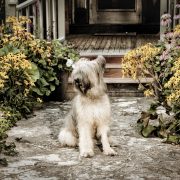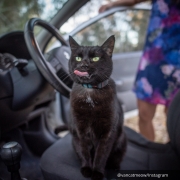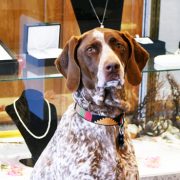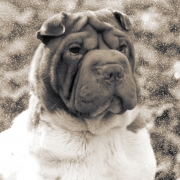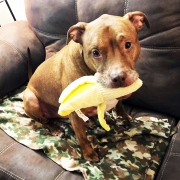5 Brilliant Artists & Their Muses
By CHERESE COBB
Who can resist a dog’s charms? Not you, not me, not even these five famous artists—whose mutt muses sniffed their way into some of their owners’ most iconic pieces.
Frida Kahlo’s Self-Portrait with Small Monkey
On September 17, 1925, Mexican artist Frida Kahlo, who was already making plans to attend medical school, and her boyfriend Alejandro Gómez Arias were riding in a school bus that collided with a street car. Frida said that a “handrail pierced me the way a sword pierces a bull,” entering through her left hip and exiting through her genitals. Her spinal column and pelvis were each broken in three places. She also broke her collarbone and suffered two broken ribs. Her right leg, the one deformed by polio, was shattered, fractured in 11 places, and her right foot was dislocated and completely crushed.
Although she recovered from her injuries—after three months in a full body cast—she suffered from infertility so she adopted several pets and treated them like her surrogate children. Her favorites were a spider monkey named Fulang Chang and a hairless Xoloitzcuintli (pronounced show-loh-eets-KWEENT-lee) named Mr. Xoloti, both of which she features in this work. Out of her 143 paintings, 55 of them were self-portraits, featuring her treasured furbabies and incorporating her monobrow, faint mustache, dark braids, bright flowers, corset-style shirts, and long skirts.
Charles Schulz and Snoopy
Peanuts creator Charles Schulz’s childhood dog—a black and white pointer named Spike, who would later serve as the inspiration for Snoopy—could understand 50 English words and had a habit of eating pins, tacks, and razor blades whole. He was the subject of “Sparky’s” first published cartoon, which the 15-year-old sent to Ripley’s Believe it or Not.
Snoopy, whose name was suggested by Schulz’s mother, didn’t appear in the first Li’l Folks comic strip, which ran on October 2, 1950. Instead, he trotted through several strips later with a flower that appeared to be growing out of his head. He also walked on all-fours and enjoyed playing ball, chasing sticks, and listening intently to his owner, Charlie Brown. By the mid-1950s, Schulz began to humanize Snoopy—subtly, at first—by introducing thought bubbles. By the early ’60s, he stood up and had more expressive and whimsical features. He was such a phenomenon by the late ’60s that he didn’t need Charlie Brown. “Snoopy doesn’t even know Charlie Brown’s name in most instances,” says Corry Kanzenberg, Curator of the Charles M. Schulz Museum in Santa Rosa, California. “He just calls him ‘the round-headed kid.” Snoopy also became the only character that had a fully illustrated inner life: he had at least 100 different personas, from Joe Cool to the WWI Flying Ace.
Cassius Marcellus Coolidge’s A Friend in Need
In 1903, painter Cassius Marcellus Coolidge started working for the “remembrance advertising” company Brown & Bigelow. He churned out a set of 16 oil paintings, depicting dogs testifying in court, pushing a broken-down car, and wielding a baseball bat. His most famous painting from the series, A Friend in Need, shows seven dogs sitting around a table playing poker until the wee hours of the morning. Often misnamed as Dogs Playing Poker, its title comes from the bulldog handing an ace under the table to his friend.
Reprinted as posters, calendars, and prints by cigar companies, Coolidge’s paintings were considered the epitome of lowbrow culture. While his own obituary described his greatest artistic accomplishment as having “painted many pictures of dogs,” he’s also invented photo stand-ins: old-fashioned carnival attractions where tourists stick their heads on top of cartoon figures.
Pablo Picasso’s Dog
On April 19, 1957, American photographer David Douglas Duncan brought his Dachshund named Lump, who didn’t get along with his Afghan Hound named Kublai Khan, to Pablo Picasso’s villa in the South of France. The Doxie immediately walked up to the Spanish painter and put his paws on him. Picasso looked down and said, “Buenos dias, amigo!” Then Lump leaped into his arms and gave him a kiss. A mutual love affair began. “He more or less said, ‘I’m staying here.’ And he did, for the next six years,” Duncan recalled in an interview on a visit to Paris.
Picasso described Lump—which means “rascal” in German—as indescribable: “Lump, he’s not a dog, he’s not a little man, he’s somebody else.” He also honored him by including him in several sketches and more than 40 paintings, which were based on Diego Velázquez’s Las Meninas. Lump, who was suffering from a spinal problem common to his breed, passed away ten days before Picasso, on March 29, 1973.
Edvard Munch’s Dog’s Face
Edvard Munch is famous today as the creator of a single image, The Scream. His painting of a sexless, twisted, fetal-faced creature with mouth and eyes open wide in a shriek of horror captured the illness, madness and death that accompanied him throughout his life. His mother died of tuberculosis when he was 5, an older sister 10 years later, another sister went mad, his father and a brother died before he was 30, and the artist himself had a severe nervous breakdown when he was 45. He also struggled with alcoholism and bipolar disorder with psychosis, which lead up to him shooting two joints off his left hand’s ring finger.
In his later years, Munch, who never married, withdrew from society, living alone without servants or housekeepers. Only his dog Fips, who had “an old sage’s soul living inside of him,” kept him company while he devoted his time to his paintings, which he sometimes referred to as his children. Munch even took his dog to Roede’s cinema, where they watched Charlie Chaplin’s films together. If Fips no longer enjoyed the film, he would start barking and they would immediately leave the show.






